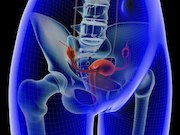Ovarian volume, follicles per ovary measuring 9 mm or smaller were most accurate for ID’ing PCOS
WEDNESDAY, Nov. 29, 2017 (HealthDay News) — For adolescents with suspicion for polycystic ovary syndrome (PCOS), magnetic resonance (MR) imaging-based ovarian morphologic measurements can help with diagnosis, according to a study published in the December issue of Radiology.
Maxime Fondin, M.D., from INSERM U1018 in Le Kremlin Bicêtre, France, and colleagues matched a case group with high (40 girls with hyperandrogenism and oligomenorrhea or amenorrhea), intermediate (eight girls with hyperandrogenism), and low (seven girls with oligomenorrhea or amenorrhea) suspicion of PCOS with 55 control subjects with no clinical hyperandrogenism, oligomenorrhea, or amenorrhea.
The researchers observed significant correlations for all criteria except sphericity index and absence of a dominant follicle with the level of suspicion of PCOS. The areas under the receiver operating characteristic curve were significantly greater than 0.5 for the number of follicles per ovary (FPO) measuring 9 mm or smaller (FPO-9), FPO measuring 5 mm or smaller, and ovarian volume (OV), respectively (0.78, 0.73, and 0.77, respectively). Sensitivity and specificity were 33 and 95 percent, respectively, for peripheral distribution of follicles, and 90 and 27 percent, respectively, for absence of a dominant follicle. Reproducibility was highest for OV (intraclass correlation coefficient, 0.89).
“The most accurate MR imaging-based diagnostic criteria for PCOS were OV, FPO-9, and peripheral distribution of follicles; however, reproducibility of these measures was moderate, except that for OV,” the authors write.
Copyright © 2017 HealthDay. All rights reserved.








